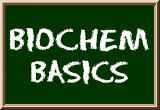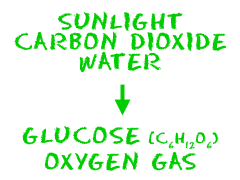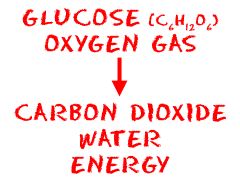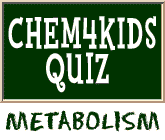
Metabolism
Metabolism is such a big word to explain a simple idea. We all need energy to survive. Whether we are plants, animals, or bacteria, we all need energy. Energy doesn't just float around in a form we can use to survive. We need to eat (mainly sugars) and digest food. That process of chemical digestion and its related reactions is called metabolism. Metabolism is the total of all the chemical reactions an organism needs to survive. Sounds a lot like biology. Why is it here in biochemistry? There are two main chemical processes that make our world go round, involving two simple chemical reactions. The first is called glycolysis. That's the breakdown of sugars. The second process is called photosynthesis. That is the series of reactions that builds sugars. You need to remember that the overall metabolism of an organism includes thousands of chemical reactions. The reactions in glycolysis and photosynthesis are just the cornerstones to life.
Sounds a lot like biology. Why is it here in biochemistry? There are two main chemical processes that make our world go round, involving two simple chemical reactions. The first is called glycolysis. That's the breakdown of sugars. The second process is called photosynthesis. That is the series of reactions that builds sugars. You need to remember that the overall metabolism of an organism includes thousands of chemical reactions. The reactions in glycolysis and photosynthesis are just the cornerstones to life.
Building Up
First, you need to build up the molecules that store energy. We'll start with photosynthesis. It's no use explaining the breakdown of sugars without telling you how they were made:LIGHT (Energy) + CO2 + H2O --> C6H12O6 + O2
You will only find this reaction in plants and algae (maybe some bacteria). They take sunlight and combine carbon dioxide (CO2) and water (H2O). Then they create glucose (C6H12O6) and oxygen gas (O2). Chemists say that they are fixing the atmospheric carbon (C). Remember, plants put the energy in glucose. Glucose is in most of the foods you eat, and the oxygen you breathe comes from those plants. Even if you have a piece of meat, that animal was originally able to get its glucose from a plant. You need to understand just how important plants are to you and the rest of life on Earth.
Breaking Down
Respiration is a three-step process that includes glycolysis, the Krebs cycle, and a bunch of electrons being pushed around the membranes of mitochondria. Together they take that energy out of the sugar-related molecules. Glucose is combined with oxygen and releases usable energy, carbon dioxide, and water.C6H12O6 + O2--> Usable Energy (ATP) + CO2 + H2O
 Cells can use that extra energy to power their functions. The energy isn't just floating around. It's stored in an excitable compound called ATP (adenosine triphosphate). ATP is the power molecule used by all the cells of an organism to power the secondary reactions that keep us alive. You may also hear about other power molecules like NADH, NADPH, or FADH. These are equally important as ATP, but they are used less often. We exhale carbon dioxide when we breathe. That CO2 comes from the breakdown of glucose in our mitochondria. As we just told you, plants can take in that carbon dioxide and use it to make sugars. Did you know that plants also create CO2? They might not breathe it out the way we do, but plants need energy too. They break down sugars in their cells and release CO2 just like us.
Cells can use that extra energy to power their functions. The energy isn't just floating around. It's stored in an excitable compound called ATP (adenosine triphosphate). ATP is the power molecule used by all the cells of an organism to power the secondary reactions that keep us alive. You may also hear about other power molecules like NADH, NADPH, or FADH. These are equally important as ATP, but they are used less often. We exhale carbon dioxide when we breathe. That CO2 comes from the breakdown of glucose in our mitochondria. As we just told you, plants can take in that carbon dioxide and use it to make sugars. Did you know that plants also create CO2? They might not breathe it out the way we do, but plants need energy too. They break down sugars in their cells and release CO2 just like us.
► NEXT PAGE ON BIOCHEMISTRY
► NEXT STOP ON SITE TOUR
► METABOLISM QUIZ
► RETURN TO TOP OF PAGE
► Or search the sites...
► NEXT STOP ON SITE TOUR
► METABOLISM QUIZ
► RETURN TO TOP OF PAGE
► Or search the sites...
Related Video...
Chalk Talk: Mitochondria (US-NSF Video)



